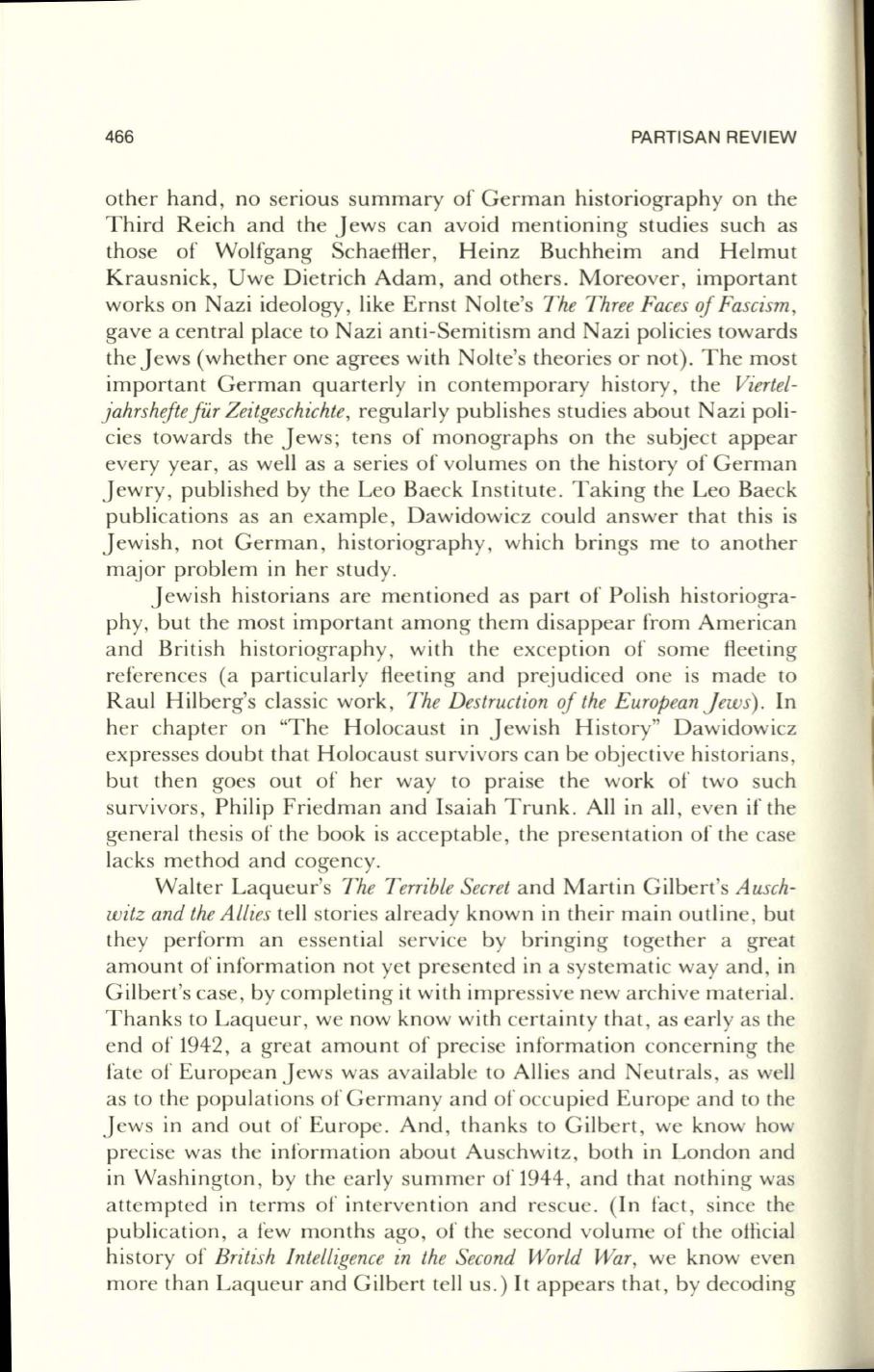
466
PARTISAN REVIEW
other ha nd , no serious summa ry of Germa n hi storiography on the
Third R eich a nd the J ews can avo id men tioning studi es such as
those of Wolfgang Schaef-Her, H einz Buchheim a nd H elmut
Kra usnick, Uwe Dietrich Adam , and others. M oreove r , impo rta n t
wo rks on Naz i ideology, like E rnst Nolte's
T he T hree Faces
of
Fascism,
gave a central place to Naz i a nti- Semitism a nd Naz i policies towards
the J ews (whether one agrees with Nolte's theori es o r not). T he mos t
importa nt Ge rman qu a rterl y in contempora ry histo ry, the
Viertel–
j ahrshiftejur Zeitgeschichte,
regul a rl y publishes studies a bout Naz i poli–
cies towa rds the J ews; te ns of monogra phs on the subj ec t a ppear
eve ry year , as well as a se ries o f volumes on the hi sto ry of Ge rma n
J ewry, published by the Leo Baeck Insti tute . Taking the Leo Baeck
publica ti ons as a n example, D awidowi cz could a nswer tha t thi s is
J ewi sh , no t Germa n , hi stori ogra phy, which brings me to a nother
maj or problem in he r study.
J ewi sh hi stori a ns a re menti oned as pa rt o f Polish hi sto riogra–
phy, but the mos t importa nt among them di sappear from Ame rican
a nd British hi storiogra phy, with the exception o f some fl ee ting
refe rences (a particul a rl y fl ee tin g a nd prej udi ced one is made to
R aul Hilberg's cl ass ic work ,
T he Destruction oj the European J ews) .
In
her chapter on "The H olocaust in J ew ish History" Dawidow icz
expresses doubt that H olocaust su rv ivo rs can be obj ect ive hi storia ns,
but the n goes out o f her way to pra ise the work of two such
survivors, Philip Fri edma n a nd Isaiah Trunk . All in a ll , even if the
genera l thes is o f the book is acce ptable, the prese n ta tion of the case
lacks method a nd cogency.
Wa lter Laqueu r's
T he Terrible Secret
a nd M a rtin G ilbert's
Ausch–
witz and the A llies
tell sto ri es a lready known in the ir ma in ou tline, bu t
they perform a n esse n tial se rvice by bringin g toge ther a great
amount o f informa ti on not yet presented in a sys tema ti c way a nd, in
G ilbe rt's case, by compl eting it with impress ive new a rchi ve mate ri al.
T ha nks to Laqueur , we now know with ce rta inty tha t, as ea rl y as the
end of 1942, a great amoun t of prec ise info rmat ion conce rning the
fa te o f Eu ropean J ews was avail a ble to Alli es a nd Neut rals, as we ll
as to the popula ti ons o f Ge rma ny a nd o f occupied Europe a nd to the
J ews in a nd out o f Europe. And , tha nks to G ilbert , we know how
prec ise was the informa tion about Auschwitz, bo th in London a nd
in Was hington , by the earl y summer of 1944, a nd tha t no thing was
a ttempted in te rms of in te rvention a nd rescue. (In fact, since the
pu bli ca ti on , a few mon ths ago, o f the second volume o f the o lii cial
histo ry of
British I ntelligence in the Second World War,
we know even
more tha n Laqueu r a nd G ilbert tell us.)
It
a ppears that, by decoding


